|
Touring the World of Tomorrow
by Bob Brooke
The 1939 New York World’s Fair promised
to be exciting and innovative for the thousands of people who passed
through its gates. It presented “The World of Tomorrow”—a technological
glimpse into the future. At the time of the Fair, the future was 1960.
That’s long since past and the future is now 2060.
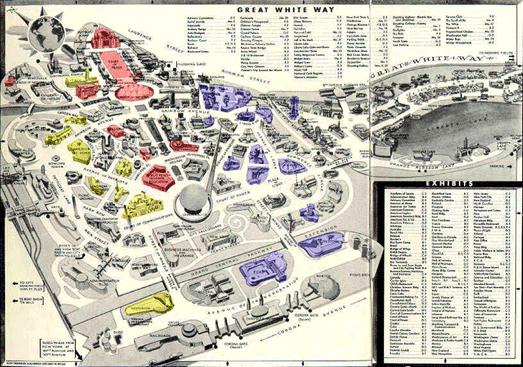
As it was planned, the World of Tomorrow was the world’s first
interactive experience. Up to that time, visitors went to world’s fairs
to look at things. But at this Fair, they got to take part in the
experience.
 The
Fair’s organizers divided it into six thematic zones—the Theme Center,
the Government Zone, the Communication Zone, the Production and
Distribution Zone, the Food Zone, and the Amusement Area----each
shuffling masses of people from one exhibit to the next either with
roads or passageways for logical transition between spaces or with the
flash of elaborate imagery that has come to be called "eye candy." The
Theme Center, with its iconic Trylon and Perisphere, acted as the Fair’s
focal point. The long promenade of Constitution Mall stretched from the
Center to the Court of Peace, much like the National Mall stretches from
the Capitol Building to the Washington Monument in Washington, D.C. The
Fair’s organizers divided it into six thematic zones—the Theme Center,
the Government Zone, the Communication Zone, the Production and
Distribution Zone, the Food Zone, and the Amusement Area----each
shuffling masses of people from one exhibit to the next either with
roads or passageways for logical transition between spaces or with the
flash of elaborate imagery that has come to be called "eye candy." The
Theme Center, with its iconic Trylon and Perisphere, acted as the Fair’s
focal point. The long promenade of Constitution Mall stretched from the
Center to the Court of Peace, much like the National Mall stretches from
the Capitol Building to the Washington Monument in Washington, D.C.
The New York World’s Fair displayed products and ideas in a variety of
ways. Exhibitors produced over 200 films for the it. Corporations
created theatrical exhibits which pitted people against machine to
promote their vision of leisure and efficiency through automation.
Variety shows and musical revues, frequently masked as educational
exhibitions, dotted the Amusement Area. Perhaps most striking were the
dioramas, which presented Utopian visions of the future using
small-scale models of towns and cities.
The Trylon and Perisphere
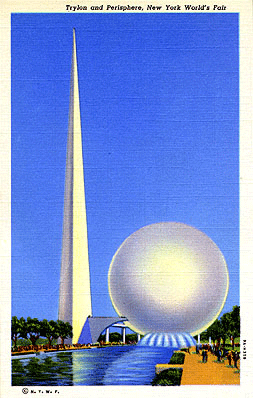 Fairgoers
began their tour of the future at the Theme Center. Designed by the
architectural firm of Harrison & Foulihoux, the Trylon and Perisphere,
the only structures in the fair permitted to be painted pure white,
reflected the emphasis on purity practiced by industrial designers of
the day. Fairgoers
began their tour of the future at the Theme Center. Designed by the
architectural firm of Harrison & Foulihoux, the Trylon and Perisphere,
the only structures in the fair permitted to be painted pure white,
reflected the emphasis on purity practiced by industrial designers of
the day.
A giant ramp called the Helicline, which connected the 700-foot Trylon
and 200-foot Perisphere, led visitors back to the grounds once they had
visited the structures. Fairgoers entered the interior of the Theme
Center by riding a portion of the way up the Trylon in what was, at the
time, the world’s largest escalator. From the Trylon, visitors moved
into the Perisphere to view “Democracity,” a diorama showcasing a
planned urban and exurban complex of the future. While viewing the
diorama, visitors listened to a recorded six-minute message of the
future spoken by H.V. Kaltenborn, popular newscaster at the time,
followed by a film show presenting "happy farmers and workers."
The Transportation Zone
While the Trylon and Perisphere represented the most recognizeable icons
of the Fair, the commercial and industrial buildings dominated the site
both in size and number; without question they covered most of the
fairgrounds. These structures surrounded the Theme Center on streets
with names such as the Court of Communications, the Avenue of Patriots,
the Avenue of Pioneers, the Avenue of Labor, and the Court of Power.
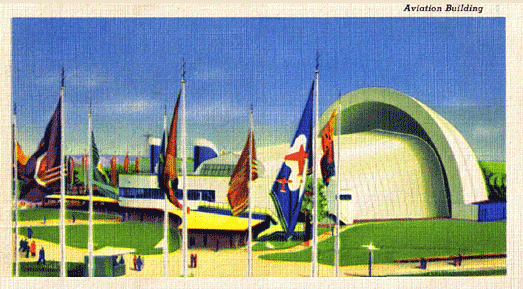
Futurama
The most popular exhibit at the Fair was undoubtedly the Futurama
presentation at the General Motors Pavilion. Designed by industrial arts
wiz Norman Bel Geddes, Futurama was a massive, 36,000 square-foot scale
model of America in 1960, complete with futuristic homes, urban
complexes, bridges, dams, surrounding landscape, and, most important, an
advanced highway system which permitted speeds of 100 miles per hour.
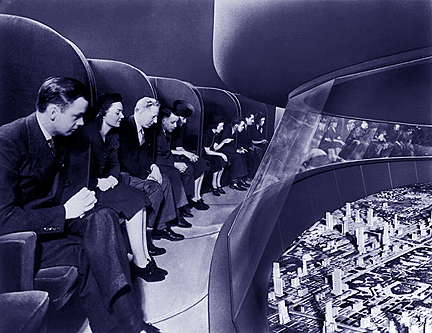 Visitors
viewed the exhibit from moving chairs with individual loudspeakers,
taking in what was supposed to be 3000 square miles of American progress
and prosperity, the virtual wonderland of the future. GM’s vision of
1960 wasn’t far off the mark. Visitors
viewed the exhibit from moving chairs with individual loudspeakers,
taking in what was supposed to be 3000 square miles of American progress
and prosperity, the virtual wonderland of the future. GM’s vision of
1960 wasn’t far off the mark.
Ford had just as impressive an exhibit. A half-mile winding road, the
Road of Tomorrow,
took visitors on highways with spiral ramps which could take traffic
from local roads below to the express highway above. Sound familiar?
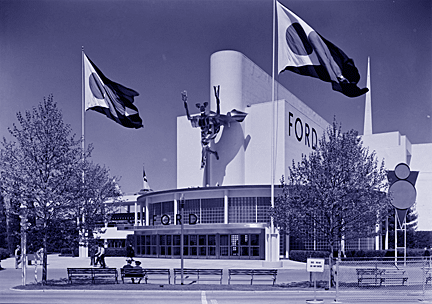 The
Ford Cycle of Production, a turntable 100 feet in diameter, weighing 152
tons and floating in 20,000 gallons of water, was the highlight of the
exhibit. The Cycle rotated, displaying models telling the story of how
the automobile industry spreads employment, from the producers of raw
materials to parts suppliers to assembly workers to sales associates.
Basically, Ford’s exhibit told visitors that technology was good for
them. The
Ford Cycle of Production, a turntable 100 feet in diameter, weighing 152
tons and floating in 20,000 gallons of water, was the highlight of the
exhibit. The Cycle rotated, displaying models telling the story of how
the automobile industry spreads employment, from the producers of raw
materials to parts suppliers to assembly workers to sales associates.
Basically, Ford’s exhibit told visitors that technology was good for
them.
While automobile travel took center stage, the Fair also showed how
advancements in travel by air, sea, and rail would affect mobility of
the future.
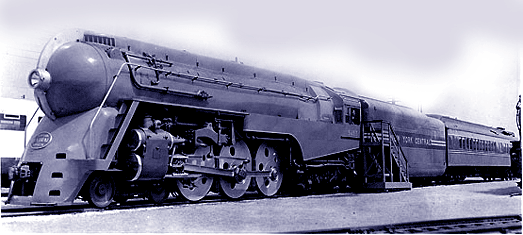
The Railways complex, the Marine Transportation building, and the
Aviation building established a major architectural theme to be repeated
throughout the Fair. The Aviation Building, designed by William Lescaze
and J. Gordon Carr, appeared took the form of an airplane hangar while
the Marine Transportation Building exhibited twin ship’s prows on its
facade, emblematic of the massive ships of the future. The Railroads
exhibit included the largest and fastest train of the day, Raymond
Loewy’s 140-foot, 526-ton steam locomotive, the 6100. The Railroads
Building, itself, was the largest at the Fair and included a 160-by-40
foot diorama with 500 pieces of equipment demonstrating the processes of
a functioning train and railroad in a 40-minute show.
The Communication Zone
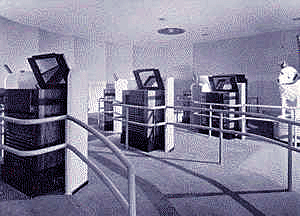 One
of the most exciting areas of the Fair was the Communication Zone.
Visitors saw for the first time, technology of the virtual kind. The
telephone and the radio, both a part of daily life, played leading
roles, as did the new medium of television. One
of the most exciting areas of the Fair was the Communication Zone.
Visitors saw for the first time, technology of the virtual kind. The
telephone and the radio, both a part of daily life, played leading
roles, as did the new medium of television.
As visitors exited the Perisphere's Helicline, they found themselves
standing in front of the American Telephone & Telegraph (AT&T) Building.
At the time of The World of Tomorrow, it was still common to have to
connect with a telephone operator in order to make a call. The AT&T
exhibition demonstrated advancements in person-to-person calling and
long-distance calling by providing the opportunity for fair-goers,
chosen by lot, to make a free long distance call from the Demonstration
Call Room.
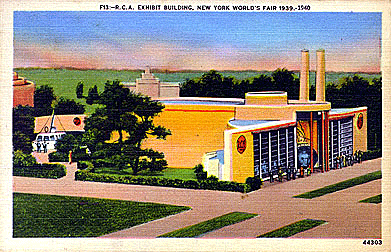 But
the RCA Pavilion held the real treasure. Shaped like a radio tube, the
RCA exhibition contained a massive glass window illuminating a mural
dedicated to the accomplishments of RCA technology. But
the RCA Pavilion held the real treasure. Shaped like a radio tube, the
RCA exhibition contained a massive glass window illuminating a mural
dedicated to the accomplishments of RCA technology.
The newest technological kid on the block was television. In the
original televisions, people viewed the image reflected from a mirror in
the lid. The first public television broadcast occurred on the Fair’s
Opening Day. Television, it seemed, could bring living images right into
everyone’s homes. It was for many, the embodiment of The World of
Tomorrow.
The City of Light diorama
Considered the world's largest diorama and stretching the length of a
city block. The City of Light featured a completely lighted, colored,
and animated version of the New York City. These buildings lit up the
Fair and provided the power for Futurama, the new air-conditioning, and
all the products and events. This was the land of research and
development, the point of entry into the World of Tomorrow.
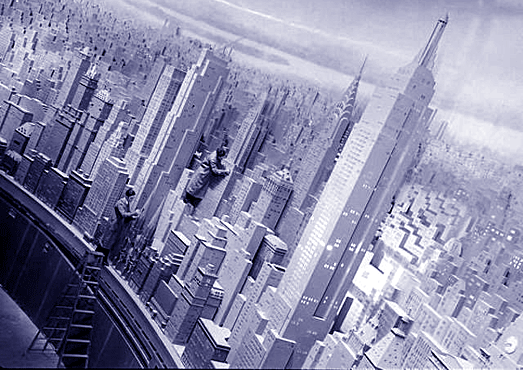
The Food Zone
Most of the buildings representing food and drink products lined
Constitution Mall, between the Avenue of Patriots and the Avenue of
Pioneers. This was the Food Zone. These weren’t necessarily restaurants
or food stands, but exhibits about food production of the future.
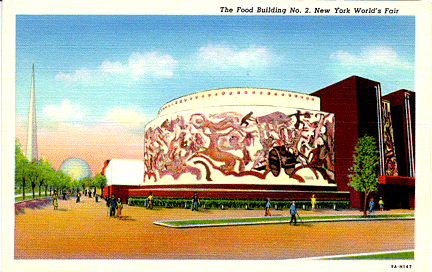 The
Food Building South was the highlight of the Food Zone. Designed by
Philip L. Goodwin who also designed the Museum of Modern Art, and Eric
Kebbon, Edward Durrell Stone, Morris Ketchum, Jr., and Richard Boring
Snow. The
Food Building South was the highlight of the Food Zone. Designed by
Philip L. Goodwin who also designed the Museum of Modern Art, and Eric
Kebbon, Edward Durrell Stone, Morris Ketchum, Jr., and Richard Boring
Snow.
Characterized by a massive Art Deco mural displaying farming and food
production, as well as four giant golden wheat stalks, the Food building
promoted the food of the future. On display were advancements in food
production, new types of restaurants, and newly developed or improved
foods.
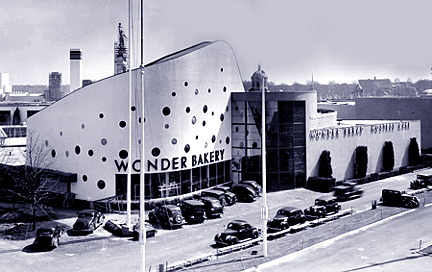 The
Continental Baking Company Building, designed by Skidmore & Owings and
John Moss, showed red, blue, and yellow balloons like those on the
wrapper of Wonder Bread. Inside the building, visitors could watch the
baking of Wonder Bread and Hostess Cakes. The
Continental Baking Company Building, designed by Skidmore & Owings and
John Moss, showed red, blue, and yellow balloons like those on the
wrapper of Wonder Bread. Inside the building, visitors could watch the
baking of Wonder Bread and Hostess Cakes.
Other structures included the Heinz Dome, the Beech-Nut Packing
Building, and the Schaefer Center, a restaurant sponsored by the
Schaefer Brewing Company which seated 1600 and had a large, open-air
bar.
The Amusement Zone
The Amusement Area, with its Fountain Lake, covered about one third of
the Fair grounds. This area represented frivolity, among all the
seriousness of promoting products. Billy Rose’s Aquacade, the highlight
of the Amusement Area located near Fountain Lake, presented a
synchronized swimming show complete with live music. It frequently
featured a young Esther Williams and Johnny Weismuller of Tarzan movie
fame.
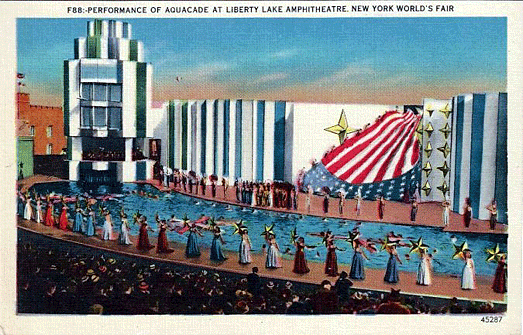
The Government Zone
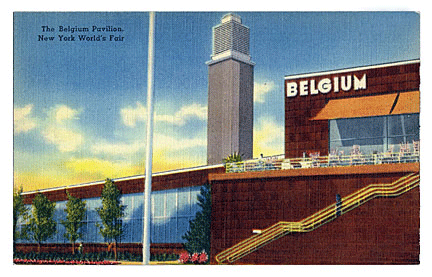 The
Government Zone was the home of the pavilions of foreign nations. The
central focus of this zone was the Lagoon of Nations, which was part of
the Flushing River, and the Bridge of Flags, combined with the Court of
Peace. More than 60 nations hosted pavilions at the 1939 fair, including
Argentina, Belgium, Brazil, Canada, Chile, France, Great Britain,
Ireland, Italy, Japan, Norway, Portugal, Romania, Sweden, the
Netherlands, Turkey, and Venezuela, plus a building representing the
League of Nations. The fair also contained a Court of States with
structures representing 33 states and Puerto Rico. The
Government Zone was the home of the pavilions of foreign nations. The
central focus of this zone was the Lagoon of Nations, which was part of
the Flushing River, and the Bridge of Flags, combined with the Court of
Peace. More than 60 nations hosted pavilions at the 1939 fair, including
Argentina, Belgium, Brazil, Canada, Chile, France, Great Britain,
Ireland, Italy, Japan, Norway, Portugal, Romania, Sweden, the
Netherlands, Turkey, and Venezuela, plus a building representing the
League of Nations. The fair also contained a Court of States with
structures representing 33 states and Puerto Rico.
You Have Seen the Future
It has been said that a visitor to the fair could attend every day for
two weeks and only skim the surface of most of its exhibits. The Fair’s
symbols, the Trylon and Perisphere, represented the chief values of The
World of Tomorrow—clarity, purity, insight, efficiency, and perfection.
Some things perhaps only achieved in a utopia.
<
Back to Back in Time
Next Article >
|
